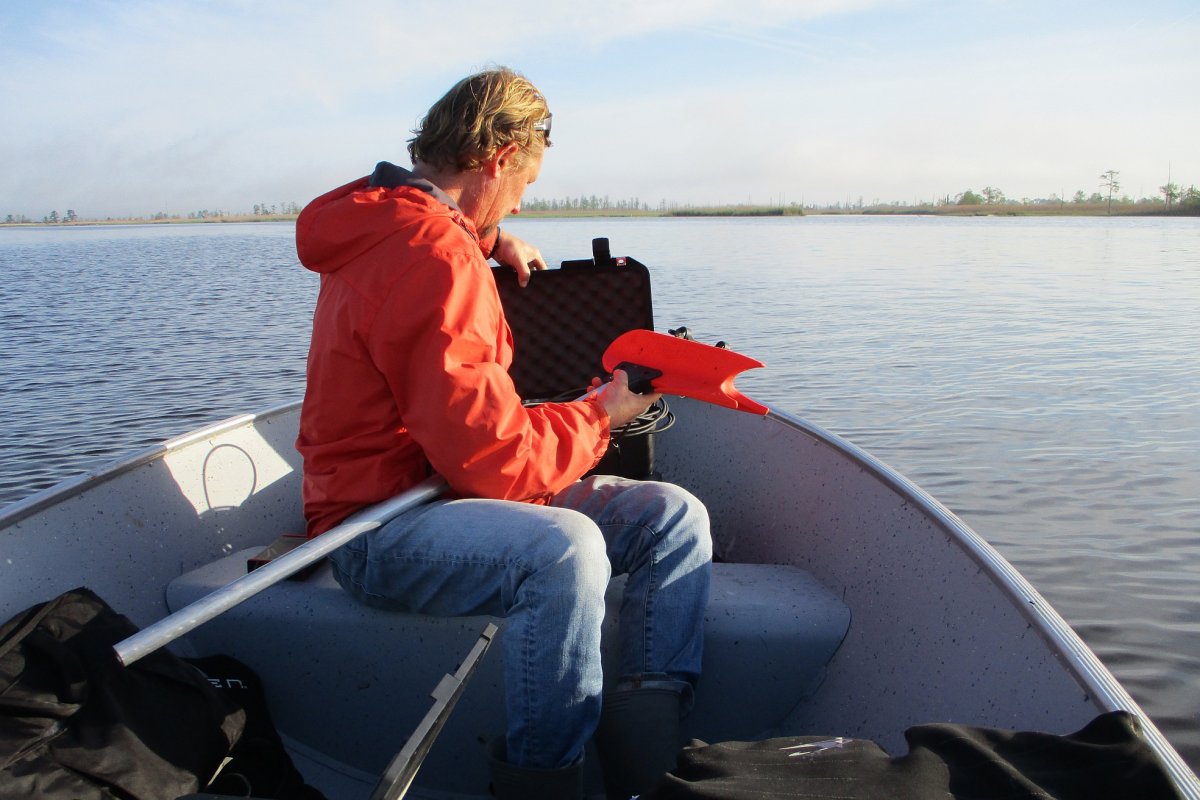Researchers have uncovered engineering feats hidden below water in North Carolina that shed light on the history of agriculture and slavery in the state.
Mark Wilde-Ramsing, a former director of the Underwater Archaeology Branch of the North Carolina Office of State Archaeology, and Joni "Osku" Backstrom, an environmental sciences assistant professor at the University of North Carolina Wilmington (UNCW), have been traversing the waters in and around Eagles Island for the past two years.
Their goal has been to document the archaeological remains of rice cultivation on the northern end of the 2,100-acre island, which is located just to the west of Wilmington, North Carolina, and nestled between the lower Cape Fear and Brunswick rivers.
"The northern end of this large island has not been altered significantly through time and thus retains several dozen weathered yet relatively intact rice fields from the 19th century," Wilde-Ramsing and Backstrom told Newsweek.

During their recent investigations, the researchers have identified various remains related to rice cultivation, including structures designed to control water.
The Eagles Island rice fields were cleared and laid out by the first quarter of the 19th century. The researchers suspect that the water control structures were largely built with the labor of enslaved Africans and their descendants—known in the region as the Gullah Geechee—the researchers said.
"Many of the water control structures we observed likely date to the construction of the rice fields in the early 19th century on the backs of enslaved Africans," Wilde-Ramsing said.
"With that said, we are no doubt also seeing repairs and reengineering that took place after the Civil War," he continued. "In the future, our hope is to have representative structures further investigated to determine their period of construction."
African agricultural knowledge and skills were critical to the success of rice cultivation along the Southeast seaboard.
"It has been documented that in the 18th century enslaved peoples, specifically women from maritime regions of West Africa, were sought out for their traditional skills and knowledge related to tidal rice cultivation in order to develop, and work, the rice fields in the Americas," the researchers said.
"Their knowledge was subsequently passed down across generations throughout the period of slavery and afterward until the early 20th century," the researchers added.
The latest research was initiated after Wilde-Ramsing observed evidence of man-made structures while rowing at low tide. The researcher had been rowing in the waters in and around Eagles Island for many years.
Wilde-Ramsing recognized that the fabricated, wooden remains he spotted had not been documented and yet they appeared to be critical features for the understanding of local rice cultivation.
The researcher then teamed up with Backstrom to investigate the area using a customized underwater sidescan sonar system that the UNCW environmental sciences professor had designed.
The sonar system, a type of remote sensing survey tool, enabled the researchers to "acoustically" identify and map archaeological sites and structures within the island's shallow creeks and canal systems, which were developed over time for rice cultivation.
In their study, which has been accepted for publication in the Journal of Maritime Archaeology, the researchers identified and mapped 45 rice-related archaeological structures, in addition to a 19th-century watercraft, through a combination of visual observations and the customized sonar system.
"The artifacts consist of various wood-built, water-control structures in the form of structural dike supports, floodgates and sluices, levee repairs, bulkheads and boat landings, all of which were part of complex canal and waterway systems engineered for successful rice cultivation," the researchers said.
"Within the larger context of canals, marshlands and waterways, water control structures made of wood were an essential part of rice field operations," they said.
While wild rice from the genus Zizania had long been a staple food source for Native Americans before European colonization, domesticated rice became an important cash crop in North America from the late 17th century onward, driven by worldwide consumption. Cultivation originated along the Atlantic seaboard, centered on South Carolina, and over time spread south throughout Georgia and north into parts of North Carolina.
Rice growing operations were well established during the latter half of the 18th century and then intensified during the antebellum period before the Civil War. This was a period when the Southern plantations elevated the production and shipment of Carolina rice, which was recognized throughout the Americas and Europe. Rice production increased until reaching its peak between the 1850s and 1860s, before declining after the Civil War, which ended in 1865.
"In many areas, rice production collapsed as the loss of slave labor greatly reduced profitability," the researchers said. "In the Wilmington area, rice cultivation recovered in the 1870s by employing labor paid by plantation owners and the nearby fertilizer factories, and by using convicts housed in prison camps, all of whom were mostly African Americans."
The researchers continued: "Bringing physical evidence of rice production to light will help generate a greater understanding of this important aspect of coastal North Carolina history, largely carried on the backs of people of African descent through their knowledge, strength and perseverance."
Sean Palmer, director of UNCW's Upperman African American Cultural Center and a board member of the Gullah Geechee Cultural Heritage Corridor Commission, said in a press release: "While the rice was the cash crop of the coastal Southeast, along with Sea Island cotton and indigo, Gullah Geechee ancestors provided both the brain trust and physical labor needed to change the landscapes into spaces that created commercial yields of the crop.
"The children of West Africa, who came to be known as Gullah Geechee, were agricultural engineers who, like the rice, were harvested for their vast knowledge," Palmer said.
Do you have a tip on a science story that Newsweek should be covering? Do you have a question about archaeology? Let us know via science@newsweek.com.
Uncommon Knowledge
Newsweek is committed to challenging conventional wisdom and finding connections in the search for common ground.
Newsweek is committed to challenging conventional wisdom and finding connections in the search for common ground.
About the writer
Aristos is a Newsweek science reporter with the London, U.K., bureau. He reports on science and health topics, including; animal, ... Read more
To read how Newsweek uses AI as a newsroom tool, Click here.






